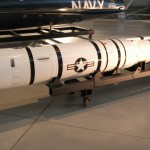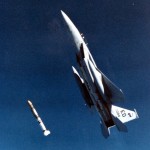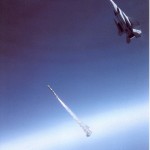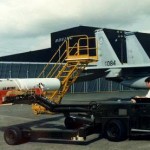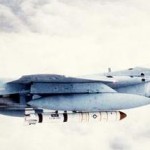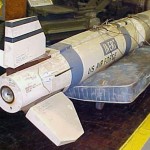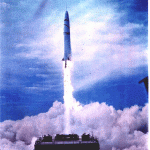
The militarization of space is an extremely controversial topic. For the most part, the world has taken the high ground (pun intended) when it comes to the war machines that are capable of destroying the planet, existing slightly above the planet’s surface.
Even as the United States and the Soviet Union worked together for years to achieve human spaceflight and research goals, the two sides essentially wiped out the first generation of satellites with nuclear warhead tests. And with the rise of China and the evolution of technology worldwide, there are no promises that space will remain neutral.
One point of contention, going back to the Cold War but emerging as recently as 2008, is the use of missiles in space. An international treaty already forbids nuclear weapons from being stored and launched from space, but what about conventional missiles? What about launching conventional missiles INTO space?
That’s where the ASM-135 “ASAT” came in. The Tom Clancy novel “Red Storm Rising” romanticizes the anti-satellite missile as a savior against Soviet space radar satellites. In reality, the ASM-135 was controversial in the 80s when it was tested, and the use of weapons to destroy satellites remains a touchy diplomatic issue.
The ASAT was developed by Ling-Temco-Vought’s LTV Aerospace division for the Air Force, to be carried exclusively on a modified F-15 “Eagle” fighter. During the program, the ASM-135 only destroyed one satellite, during a 1985 test against a malfunctioning solar observation satellite. Since then, only two such launches have taken place; one by the U.S. and one by China.
History

Research did continue, however. In May 1963, a modified Army Nike Zeus missile destroyed a satellite by using a nuclear warhead. In the late 60s, through 1975, the Army’s Thor ballistic missile stood ready to wipe out satellites with nuclear weapons also. These were both ground-launched anti-satellite missiles. The military eventually curtailed the use of nuclear weapons for ASAT purposes — not because of environmental and health concerns but out of fear that nuclear weapons would disrupt or damage American satellites as well as the intended Soviet ones. Many early communications satellites, including the Telstar television satellite were ruined by high altitude nuclear explosions created during missile tests in this era.
In 1978, the Air Force began its program for a new air-launched ASAT weapon. The resulting LTV Aerospace design for the ASM-135 was smaller than previous missiles, with infrared homing and a kinetic energy warhead instead of a nuclear blast.
Kinetic energy creates what is essentially a massive car wreck. The missile crashes directly into the target at extremely high speeds, destroying the target.
Design and Testing
The ASM-135 had three rocket stages. It was launched from an F-15A with customized electronics and modifications to take the missile in the airplane’s centerline.
Fifteen ASM-135 ASAT missiles were produced and five were fired in test flights. The third test, on September 13, 1985, destroyed the P78-1 Solwind solar observation satellite, marking the first time a conventional missile ever destroyed a satellite. The F-15 is still the only airplane ever to claim a satellite as a “kill.”
Destruction of the Solwind was controversial on its own. The satellite’s batteries were malfunctioning, but two of the instruments were still operating and sending back research data when the ASAT destroyed the satellite. An article a few months later in Science News outlined some scientists’ outrage.
At the time, the working portions of the Solwind had been photographing the the sun’s outer atmosphere over the period of an entire solar cycle, something that had never before been done from beyond the surface of the planet.
“I can’t believe that they couldn’t find a piece of space junk, really, instead of a working laboratory,” said David Rust of the Johns Hopkins University Applied Physics Laboratory in the article, written by the noted late science writer Jonathan Eberhart. “That particularly made a pitch to the university community, to the scientists, saying this is a ‘Manhattan Project’ sort of thing, and it’s good science and so forth — and then they turn around and blow up a laboratory.”
The Air Force originally intended to modify 20 F-15s from squadrons in Washington and Virginia for the ASAT program, which would have an operational force of 112 ASM-135s. Debate over the policy and need for anti-satellite weapons began to heat up, but money ultimately did in the ASM-135 project. The cost of the project ballooned from $500 million to $5.3 billion. The program was cancelled by the Ronald Reagan administration in 1988, citing the cost overruns and technical problems. Of course, the F-15s had already been modified, and the Air Force paid to launch two target satellites into space when the program was cut.
Since the ASM-135 program’s termination, two other anti-satellite launches have gone ahead successfully. In 2007, China launched what the U.S. referred to as a SC-19 ASAT missile that used kinetic energy similar to the ASM-135’s warhead to destroy a defunct Chinese weather satellite, in a demonstration of the country’s capabilities. The test drew international criticism and speculation of an “arms race in space.” The test also created a wide swath of space debris that is still in orbit and has twice presented danger to the International Space Station.
In 2008, the U.S. Navy launched a SM-3 anti-ballistic missile at a spy satellite that had failed and was in decaying orbit. The SM-3 cannot reach beyond very low orbit, but it did demonstrate that the U.S. still has a feasible means to destroy a satellite if it needs to.
There remains a delicate balance of neutrality in space, but China’s growth will continue to test this notion, especially as the country’s space program develops and China meets its own stated goal, which include putting a space station in orbit by 2020.
“Space power” remains a hot topic of discussion in the American armed forces.
Specifications
Length: 18 feet
Diameter: 20 inches
Weight: 2600 pounds
Speed: In excess of Mach 23 (15,000 mph)
Range: 403 miles
Guidance system: Infrared Homing Seeker
Warhead: Kinetic Energy Kill
Essential Reading
Online Resources:
